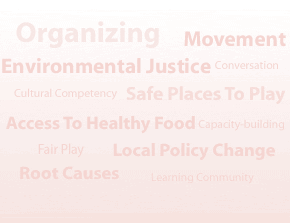There’s more to the story than the data. Communities of color not only have higher rates of childhood obesity, but less access to healthy foods, safe places to play and regular physical activity at school. Working together we can develop new public priorities that value the health of our children. CCHE is about building public support for the community interventions that can support families in leading healthier lives. To do this, it is critical that we move beyond the traditional focus on health promotion in “high-risk” racial and ethnic communities to thinking about the environmental root causes. Land use and planning policies, inequities in public education resources, retail patterns, poverty, and more exacerbate the obesity epidemic in communities of color. Limited access to healthy foods and safe places to play—even at school—and high stress related to living in poverty are among many of the challenges to individual behavior changes. While individual behavior and lifestyle changes are important pieces of a comprehensive program for change, research proves that environments in many “at risk” communities make it difficult and sometimes nearly impossible to develop healthy alternatives. There can be no comprehensive approach to tackling and reducing the obesity epidemic without support for environmental change that deals with local food, built and political environments.
A Short Interview with Makani Themba, Executive Director of Communities Creating Healthy Environments, CCHE
1. What's your vision of a healthy environment? A healthy environment is the sum total of how laws, norms, programmatic and systemic structures, institutions, communications and technology, culture, beauty, nature, the built environment as well as human relationships (including access to power and decisionmaking) are structured to support and sustain healthy communities. Concretely, this means neighborhoods that are green, recreation friendly, with affordable, sustainable housing, good jobs and healthy, fresh, affordable food produced in fair labor environments. Where children thrive feeling safe, happy and cared for. Families are supported and connected to extended networks. Education and services meet community needs. Neighbors are engaged with each other in fair, collaborative governance of their communities. There are diverse venues for communications and cultural expression and access to technology that helps augment our human and social capital. 2. What are the social dynamics and systemic hurdles to healthy living that often stand in the way of that vision in communities of color and indigenous nations? The research is clear. Our health is as much a product of environmental factors like housing, jobs, education, etc., or social determinants, as it is our individual behavior. In fact, systems, policies, institutional practices also play a significant role in shaping individual behavior. As a result of historic and present day racism and discrimination, many communities of color and indigenous nations do not have in place the kind of systems that support healthy environments. Unfair distribution of tax revenues, for example, has meant underfunded schools, fewer sidewalks and infrastructure investments and fewer parks and recreation options in communities of color. Predatory and discriminatory marketing practices have resulted in an overconcentration of unhealthy food outlets and fewer outlets selling fresh, affordable, healthy foods. For many communities, making healthy choices means navigating environments fraught with barriers. It just isn’t fair. Fortunately, there has been a real grassroots movement to turn this around. 3. What excites you most about this new initiative? CCHE will build and expand all of this great work happening all around the country to help communities solve these problems together. This initiative engages people living with the problems as leaders and changemakers, including youth organizers and leaders. It’s the best way to make change and I’m proud that CCHE will be investing significant resources where they are most needed. 4. Under the CCHE program, the Robert Wood Johnson Foundation will fund twenty groups over six years to do local policy advocacy within communities of color and indigenous nations. What's your long-term vision for how this work will impact and build power in these communities? I think the long term vision brings us back to where we started this conversation: what is our vision for healthy environments? If we do our job right, these groups will bring their own communities closer to their dream of a truly healthy place to live – and they will inspire hundreds of other communities with the work and the stories they forge along the way.
